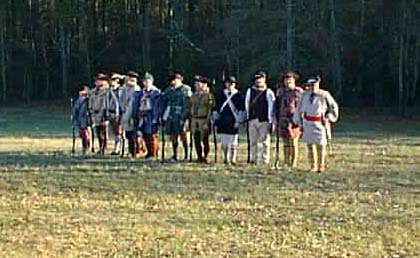The Battle Of Cowpens
The Battle of Cowpens was fought on January 17, 1781. On or about that weekend every year the National Park Service comemerates the battle with a demonstration of the weapons, tactics, and life style of that period. It is not a reenactment, since no attempt is made to recreate the battle itself, but rather it is to instruct the visotors in the life and times of the Colonial period. Each participant is very knowledgeable in his particular specialty and is more that happy to take time to discuss it with any and all visitors. There is a ceremony on Saturday where wreaths are laid on the battlefield monument by various societies dedicated to that period. Behind the spectator area is a visitors center and theater, where a film is shown on a regular basis which includes a reenactment of the battle, as well as further explanations the Revolutionary period. There is a gift shop with speciatly books of the period which are very detailed and informatative, and may be somewhat difficult to locate elsewhere.
The Colonial Camp showing a variation of an American flag.

The Colonial Militia is forming for a demonstration.

The Militia executes a right wheel.

They Colonials macrch into poxition in front of the spectator area. The yellow rope which may be seen in the foreground is to restrict the spectators.

All firing demonstartions must be done with the muskets and rifles aimed away from the spectators and toward the woods. Even though there is only black powder loaded in them, a wad striking a person can cause an injury. Also, 57% of the charge in a black powder weapon is expelled from the barrel as a solid.

The Militia fires the first volley.

They reload and fire again. This can be done at the rate of four rounds per minute with a smooth bore musket. A rifle takes longer, and because of the tight fit of the ball, fouling can become a problem after a few rounds. The loose fit of the ball in the smooth bore musket solves this problem, but at the sacrifice of range and accuracy. The musket is effective when used in mass and at close range.

This is a French patterned sword of the eighteenth century. It differs from most common patterns of the period. Note the langet. This is more representative of patterns of the early 19th Century, notably the British 1796 pattern and the Prussian 1811 pattern. The bird head pommel is also indicative of a later period, as is the guard. But the combination of these is rare, and the blade, which is dropped point, does not follow either the British or Prussian style.

A view of the other side of the sword.

A full view of the sword. It is of a high quality and very interesting. It has survived the years well.

There is also a candlelight tour of the battlefield on Saturday Night that is well worth seeing. The only limiting factor is the January weather.